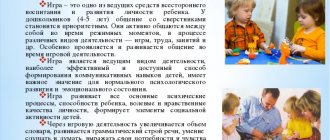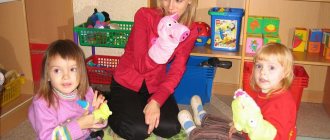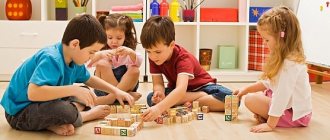Features of play activities of senior preschool age
At this stage of development of the game, word and deed come together, and role-playing behavior becomes a model of relationships between people that are meaningful to children. The stage of the actual role-playing game begins, in which the players simulate the labor and social relations of people familiar to them.
A scientific understanding of the stage-by-stage development of play activity makes it possible to develop clearer, systematized recommendations for guiding the play activities of children in different age groups.
In order to achieve a genuine, emotionally rich game, including an intellectual solution to a game problem, the teacher needs to comprehensively guide the formation, namely: purposefully enrich the child’s practical experience, gradually transferring it into a conventional game plan, and during independent games, encourage the preschooler to creatively reflect reality.
The game is dynamic where the management is aimed at its gradual formation, taking into account those factors that ensure the timely development of gaming activity at all age levels. Here it is very important to rely on the child’s personal experience. Game actions formed on its basis acquire a special emotional overtones. Otherwise, learning to play becomes mechanical. Emotions cement the game, make it exciting, create a favorable climate for relationships, increase the tone that every child needs - a share of his mental comfort, and this, in turn, becomes a condition for the preschooler’s receptivity to educational actions and joint activities with peers.
All components of a comprehensive guide to the formation of play are interconnected and equally important when working with children. As children grow older, the organization of their practical experience also changes, which is aimed at actively learning the real relationships between people in the process of joint activities. In this regard, the content of educational games and the conditions of the subject-game environment are updated. The emphasis of activating communication between adults and children shifts: it becomes businesslike, aimed at achieving joint goals. Adults act as one of the participants in the game, encouraging children to engage in joint discussions, statements, disputes, conversations, and contribute to the collective solution of game problems that reflect the joint social and labor activities of people.
So, the formation of play activities creates the necessary psychological conditions and favorable soil for the comprehensive development of the child. Comprehensive education of children, taking into account their age characteristics, requires systematization of the games used in practice, the establishment of connections between different forms of independent play and non-play activities that take place in a playful form. As you know, any activity is determined by its motive, that is, by what this activity is aimed at. Play is an activity whose motive lies within itself. This means that the child plays because he wants to play, and not for the sake of obtaining some specific result, which is typical for everyday life, work and any other productive activity.
Features of the development of role-playing games in preschoolers
Play is the creative processing of experienced impressions, combining them and building from them a new reality that meets the needs and desires of the child himself.
L. S. Vygotsky
In the 21st century, children's lives have undergone significant changes and have become very closely linked to the financial capabilities of their parents. Children are able to master television, computers, mobile phones and other gadgets faster than adults. Together with their parents, they listen to the same songs, watch the same programs on TV; visit cafes and restaurants with the family, go on vacation abroad, travel; are familiar with car brands and advertising. Children are interested in many things and are ready to talk about many things. But as before, children are focused on intrinsically valuable, childish activities. They love to fantasize, compose, have fun and, of course, play.
With the adoption of the Federal State Educational Standard, play began to be considered as the content and form of organization of life. All types of children's activities, including communication between the teacher and preschoolers, include playful moments, situations and techniques.
A special place in the activities of a preschooler is given to plot-based role-playing games. The activity side of this game is reflective in nature. An important feature of role-playing games is the presence of an imitative or completely fictitious situation in which the child plays the role of an adult and reproduces everything that he observes among adults, copying the labor or social functions of adults, modeling the relationships between them. During the game, the child shows himself to be who he wants to be, and he “is” where he wants to be, during the game he participates in interesting and attractive events.
Throughout preschool age, the dynamics of the development of play can be traced from the first level (in junior preschool age) to the fourth (in senior preschool age).
In early preschool age, children most often play alone (side by side, individual games), since they do not yet know how to negotiate with each other, distribute roles and game material. The themes of the games are mainly everyday, taken from life: impressions gained, observations of the immediate environment. Such games include: “mothers and daughters”, “kindergarten”, “car ride”, “hospital treatment”. The plots of the games are monotonous. The child takes on a certain role, but rarely behaves in accordance with this role. Children like to reproduce role-playing actions and convey role-playing behavior emotionally. Initially, the game is accompanied only by individual remarks, but over time the role-playing dialogue develops, also with an imaginary interlocutor. Children who have mastered actions with role-playing toys freely use substitute objects in the game; they know how to replace missing themed toys with other objects. Gradually, the plot-role-playing game changes - from a single game it turns into a joint game, in which two or more children participate. This transition is carried out as follows: first, the child becomes interested in a friend’s game, then he joins his friend’s game for a short time, and then the children disperse again. However, as a result of deep penetration into the lives of adults, children begin to understand that adults interact with each other, and the desire to reproduce their lives encourages children to join their friends in the game. There is a need to organize a game that includes several roles, and there is a need to discuss the course and rules of the game with other children. At a younger age, the prerequisite for starting the game is an adult’s proposal or received impressions. As a rule, games are short-lived. They last up to 10–15 minutes. All this characterizes the 1st level of game development, the main content of which is games - actions with objects.
In middle preschool age, small groups of 2-3 people (group form of organization) appear in games, who are interested in the same topics and game plots. The themes of games are becoming more and more extensive. Elements of social life are included in the game. The plots become more complex - they become detailed and varied. For children, the main thing in the plot is the reproduction of relationships between people, compliance with the rules of relationships. Role-playing dialogue becomes longer and more meaningful. Children try to convey the characteristic features of the portrayed character through movements, facial expressions, gestures, and intonation. Role-playing interaction in the game is very long - up to 40–50 minutes. Children independently choose substitute objects and easily give them and imaginary objects verbal designations. Adults play a significant role in organizing the game, but their help should not be intrusive. Children should not be offered ready-made examples of games; the teacher only helps children in organizing and progressing the game. If conflict situations arise, the teacher helps to resolve them. Gradually, children learn to control the game and organize it independently. The above characterizes the 2nd level of development of role-playing games. The essence of the game is the action with the object, which unfolds more fully and consistently, in accordance with the role that is indicated verbally. The sequence of actions becomes the rule.
At the age of 5-6 years, role-playing games are most often collective. Games are held on a wide variety of topics. In them, children reproduce events and situations that are beyond the scope of their personal experience; they want to reproduce events taking place in the life of the country and the whole world. In games, children combine knowledge gained from personal observations, books, films, and stories from adults. Children assign roles in advance and choose material for the game. Children have 7–10 roles in games, 2–3 of which are favorite. Sometimes, due to the large number of roles, children do not have time to develop a complex plot and carry out the planned actions of their roles to the end, resulting in a conflict. At this moment, the intervention of the teacher is necessary, and the children should stop the game and determine its further development. At this age, games reproduce real relationships from the surrounding life through verbal communication, so some of the actions are performed by children verbally. At 5–6 years old, it is very important for children to follow the rules of the game. If someone does not want to comply with them or does not know how to cope with the role, the rest of the participants in the game immediately notice this. All this characterizes the 3rd level of game development, at which the main content of the game remains actions with objects, but they are supplemented by actions that are aimed at establishing various contacts with game partners.
At 6–7 years old, games are joint and collective in nature. Associations are stable. The relationship between role and real relationships becomes complex. At this age, game organizers can be identified - these are children who know many stories and enjoy authority. As a rule, they take the main role. But sometimes such a child can choose a secondary role, while continuing to “lead” the entire game, determining and controlling the actions of others. Children of senior preschool age develop a director's type of role-playing game. Director's Game is a single-player game that leverages the co-op experience. In it, the child does not take on any of the roles, but is involved in directing. He divides the roles between the toys, and he only moves them, comes up with the plot of the game and dialogues between the characters. The complexity of the plots in such games can be quite high. For example, the battle of an entire army, in which there are generals, officers, intelligence officers, which is made up of toy soldiers, horsemen, guns, tanks. In addition to role-playing games, outdoor and didactic games become important in older preschool age. Their common feature is that these games have clear rules. The meaning of these games for a child comes down to strictly following the rules and winning. All this corresponds to the 4th level of game development, the main content of which is games that reflect the relationships and interactions of adults with each other.
The main thing during the preschool period is the formation and development of the child as an individual. Personal qualities are formed in the process of vigorous activity and, mainly, in that which is leading at a given age stage. Play is the leading activity in preschool age. It is the development of role-playing play that most contributes to the mental development of the child. If a child did not have time to fully play in the preschool period, then he will experience serious difficulties at the next stage of development, at school.
Literature:
- Boychenko N. A. Plot-based role-playing games for preschoolers, - Kyiv “Radyanskaya School”, 2008. - 654 p.
- Wenger L.A. Role-playing game and the mental development of a child // Game and its role in the development of a preschool child: Sat. scientific works. - M., 1978–127p.
- Ivankova R. A. Planning pedagogical work on the formation of role-playing games for children of early and preschool age // Preschool education: Traditions and modernity. - M., 2002 - No. 4–53–56.
- Krasnoshchekova, L. V. Role-playing games for preschool children [Text] / N. V. Krasnoshchekova. – Rostov n/D., 2007. - 415 p.
- Mikhailenko N. Ya. Theory of plot-role-playing games. - M.: UNITY. 2010. -365 pp.
- Mikhailenko, N. Ya. Organization of role-playing games in kindergarten: a manual for teachers [Text] / N. Ya. Mikhailenko, N. A. Korotkova. — 3rd ed., rev. - M.: LINKA-PRESS, 2009. - 96 p.
- Mikhailenko, N. Ya. How to play with a child [Text] / N. Ya. Mikhailenko, N. A. Korotkova. — 3rd ed. - M.: Obruch, 2012.
- Monakhova, D. L. The world of games and the festive - play culture of childhood [Text] / D. L. Monakhova // Preschool education. - 2011. - No. 5. - P. 161–162.
- Novoselova, S. L. Game: definition, origin, history, modernity [Text] / S. L. Novoselova // Kindergarten: from A to Z, 2003. – No. 6.
- Smirnova E.I. Modern preschooler: features of play activities.// Preschool education. 2002. - No. 4. - P. 70–74
- Ivankova R. A. Planning pedagogical work on the formation of role-playing games for children of early and preschool age // Preschool education: Traditions and modernity. - M., 2002 - No. 4–53–56.





